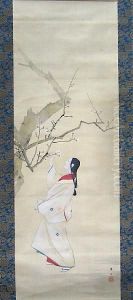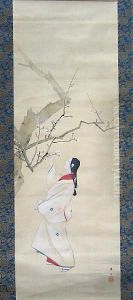Kajita Hanko Paintings
Kajita Hanko was a Japanese painter and illustrator known for his contributions to the development of Nihonga, a style of painting that sought to combine traditional Japanese aesthetics with Western techniques and materials. Born on September 15, 1870, in Toyama Prefecture, Japan, Hanko was initially trained in the traditional Kano school of painting. He later moved to Tokyo to further his studies and broaden his artistic horizons.
In Tokyo, Hanko studied under Hashimoto Gaho, a prominent Nihonga artist who was influential in his development. Hanko quickly became known for his unique style, which blended the detailed line work of the Kano school with more modern elements. He was particularly noted for his bijinga (pictures of beautiful women) and illustrations that often depicted historical or mythical themes. His works were characterized by their elegant and refined lines, as well as their use of color and attention to detail.
Hanko's career flourished in the Meiji and Taisho periods, a time when Japan was rapidly modernizing and looking to the West for inspiration while also trying to maintain its own cultural identity. He exhibited his work at various expositions and was awarded multiple times, solidifying his reputation as a leading artist in the Nihonga movement. Throughout his career, Hanko also worked as an illustrator, contributing to books and magazines, and thus helping to popularize Nihonga style across different mediums.
Kajita Hanko passed away on December 19, 1917, leaving behind a legacy as an artist who played a significant role in the evolution of Japanese painting. His work continues to be appreciated for its aesthetic qualities and as an example of the fusion between East and West that defined the Nihonga style.

